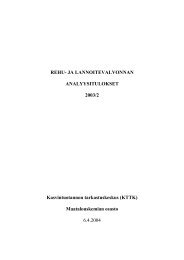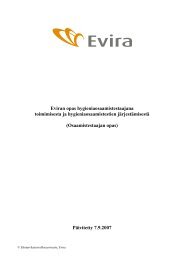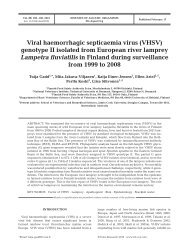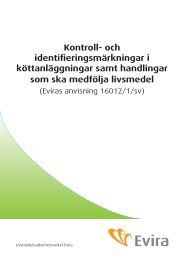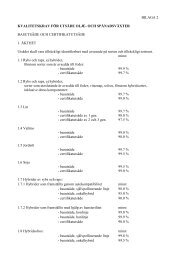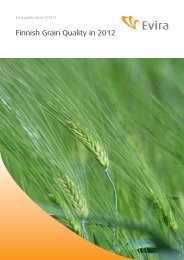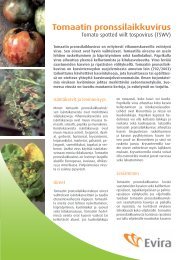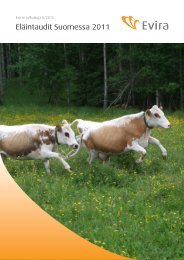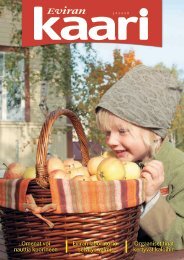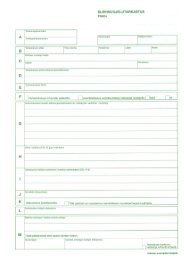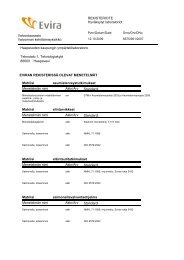Molecular characterization of endemic salmonella infections ... - Evira
Molecular characterization of endemic salmonella infections ... - Evira
Molecular characterization of endemic salmonella infections ... - Evira
Create successful ePaper yourself
Turn your PDF publications into a flip-book with our unique Google optimized e-Paper software.
4.1.3 S. Typhimurium DT1 isolates (IV)<br />
The isolates (total n = 255) were obtained from the National Public Health Institute, Helsinki,<br />
Finland (n = 140) and from the Finnish Food Safety Authority <strong>Evira</strong> (EELA is a part <strong>of</strong> it), Helsinki,<br />
Finland (n = 115). The isolates were obtained from humans, animals, feed, or the environment<br />
from 1972 to 1999. They were chosen among all available isolates <strong>of</strong> S. Typhimurium DT1 based<br />
on details <strong>of</strong> origin (animal species, date or year <strong>of</strong> isolation, geographical location) in order to get<br />
as representative a material as possible. In practice the isolates had to be widely distributed both<br />
in time and location. The isolates from humans from 1972 to 1999 were classified either as<br />
domestic (a patient had not been abroad during the month preceding the time when the specimen<br />
was taken) or foreign based on the recent travelling history <strong>of</strong> the patient. However, in judging<br />
whether the origin <strong>of</strong> an isolate is domestic or foreign in origin, there is always the risk <strong>of</strong><br />
misclassification. Most <strong>of</strong> the isolates <strong>of</strong> foreign origin were from countries to which tourism from<br />
Finland is common. Travellers might have already had the Salmonella bacteria when leaving home<br />
for the respective destination. The Salmonella isolation might have been carried out after returning<br />
to Finland, and the isolate threfore classified as ‘foreign’ based on the basis <strong>of</strong> recent foreign<br />
travel. Such a misclassification might be easier to detect as S. Typhimurium DT1 is rare as an<br />
infection source in many countries. The domestic isolates were isolates obtained from outbreaks<br />
(for the period 1972 to 1988). The other isolates were obtained from outbreaks or sporadic cases<br />
(1990 to 1999). In either case, all isolates had been serologically confirmed to be S. Typhimurium,<br />
phage typed as DT1 and stored at -70°C, except for the isolates obtained in the 1980s, which had<br />
been stored on egg agar slopes prior to analysis.<br />
4.2 METHODS<br />
4.2.1 Pulsed-field gel electrophoresis (PFGE) (I-IV)<br />
Preparation <strong>of</strong> PFGE-samples (I-IV). Chromosomal DNA was prepared in gel blocks as described<br />
previously by Birren and Lai (1993), but with some modifications. Bacteria were harvested from 1.1<br />
ml <strong>of</strong> an overnight culture. Agarose (1% low melting) was used for the plugs (InCert Agarose, FMC<br />
BioProducts, Rockland, ME, USA). Lysozyme treatment at 37°C for 4 hrs was followed by<br />
proteinase K at 50 °C for 20 hrs. The plugs were stored in 0.5 M EDTA at 4 °C.<br />
XbaI and S1-nuclease digestion for PFGE (I-IV). The agarose plugs were dialysed against 10 mM<br />
Tris, pH 7.4, 1 mM EDTA, 50 mM NaCl before treatment. Restriction enzyme and S1-nuclease<br />
analyses were performed using slices from the same plugs. The slices were digested at 37°C for<br />
16 - 18 hrs, with 20 units <strong>of</strong> XbaI in the reaction buffer supplied by the manufacturer (New England<br />
45



